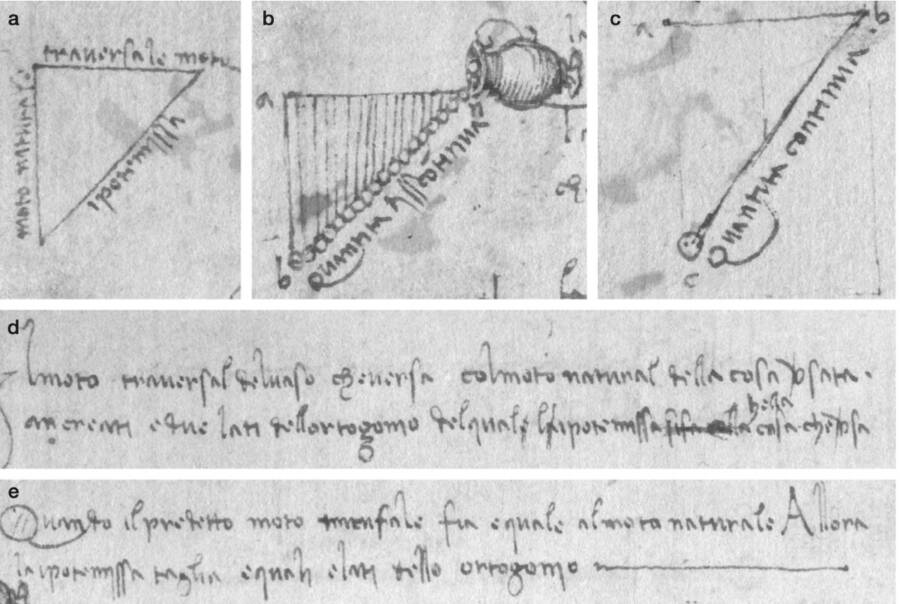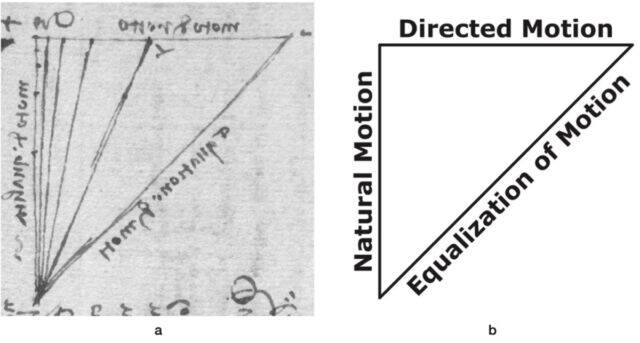A new study examining some of Leonardo da Vinci's sketches in the Codex Arundel reveals the artist calculated the earth's gravitational constant at a 97% accuracy rate.

FierceAbin/Getty ImagesA portrait of Leonardo da Vinci, the famous 15th and 16th-century inventor and artist.
In 2017, California Institute of Technology professor Mory Gharib was searching the Codex Arundel, a collection of notes and sketches by Leonardo da Vinci dating from 1480 to 1518, for illustrations that he could share with his graduate students when he noticed a particularly intriguing sketch.
The illustration depicted a jar pouring out sand, as well as a series of triangles appearing to measure its movement.
“What caught my eye was when he wrote ‘Equatione di Moti’ on the hypotenuse of one of his sketched triangles,” Gharib said in an article from the California Institute of Technology. That phrase means “equalization (equivalence) of motions,” Gharib explained. “I became interested to see what Leonardo meant by that.”
Alongside engineers Chris Roh and Flavio Noca, Gharib began investigating the sketches and soon realized that they were not simply drawings of geometric shapes, but evidence that da Vinci had started to decode the laws of gravity decades before Isaac Newton “discovered” it.
The trio published their groundbreaking conclusions in the journal Leonardo. Per their research, Leonardo da Vinci had illustrated that gravity is a form of acceleration. He also appeared to demonstrate Earth’s gravitational constant at a 97% accuracy — almost 200 years before Newton published his law of universal gravitation.
Today, Leonardo da Vinci’s name is synonymous with genius. Born in Italy in 1452, da Vinci would go on to explore his artistic and scientific interests, becoming a leading figure in the Italian Renaissance, a period of burgeoning artistic and intellectual curiosity.
Historians are able to view just how much of a genius the man was through the notebooks he left behind. A collection of over 13,000 pages, da Vinci’s notebooks are full of sketches depicting human anatomy, flying machines, and even weapons that would not exist for hundreds of years — including machine guns and missiles.

Gharib et al., Leonardo, 2022Leonardo da Vinci’s sketches detailing a rudimentary way of calculating Earth’s gravitational constant.
People around the world know da Vinci for his inventions and his iconic works of art like the Mona Lisa and The Last Supper. But until Gharib and his team discovered da Vinci’s triangle sketches, no one suspected that the Italian artist may have been the first person to begin decoding the laws of gravity.
Through these sketches, Leonardo da Vinci attempted to calculate the movement of falling sand. According to the California Institute of Technology article, da Vinci wrote that when a pitcher was held at a fixed height and moved at a constant speed, the sand would fall vertically toward the ground as it was poured out.
To depict this, Da Vinci drew a horizontal straight line representing the movement of the vase, and a vertical line representing the sand’s movement.
Then, da Vinci noted that if the pitcher’s speed increased at a constant rate or accelerated, the sand would still fall in a straight line but at a slanted angle.
Significantly, da Vinci also observed that if the pitcher accelerated at the same rate that gravity accelerated the falling sand, it created an equilateral triangle — as noted in the “Equatione di Moti” diagram.
“What is Leonardo trying to do?” Gharib told Arstechnica. “He’s trying to say, ‘If I could move my hand or move the jar the same way that gravity acts on particles’ — in this case, sand — ‘if in a given time they travel the same distance, then I have mimicked the gravity just by acceleration.’
“He calls it the act of motion,” Gharib continued. “He does it in a different direction than gravity. So that means he clearly understood that gravity is a kind of acceleration, but toward the Earth — otherwise he would not have tried to mimic it by acceleration.”

Gharib et al., Leonardo, 2022Leonardo Da Vinci’s sketches labeling each side of a triangle with its corresponding force, with directed motion representing the acceleration of the vase and the equalization of motion representing the path of the falling sand.
According to the engineers, da Vinci was unable to formulate an accurate mathematical equation to calculate the gravitational constant.
“What we saw is that Leonardo wrestled with this, but he modeled it as the falling object’s distance was proportional to 2 to the t power [with t representing time] instead proportional to t squared,” Roh said in the California Institute of Technology article. “It’s wrong, but we later found out that he used this sort of wrong equation in the correct way.”
Despite failing to calculate the gravitational constant, da Vinci’s efforts are tremendously impressive given the tools available at the time. Da Vinci lived in a world that had not yet invented calculus, discovered inertia, or had accurate ways to measure time. Despite this, da Vinci’s measurement for the earth’s gravitational constant was 97% accurate.
“We don’t know if da Vinci did further experiments or probed this question more deeply,” Gharib said. “But the fact that he was grappling with this problem in this way — in the early 1500s — demonstrates just how far ahead his thinking was.”
After reading about Leonardo da Vinci’s gravitational experiments, learn about six of his inventions that changed the modern world. Then, read about how Margaret Hamilton’s work allowed NASA to land on the moon.





